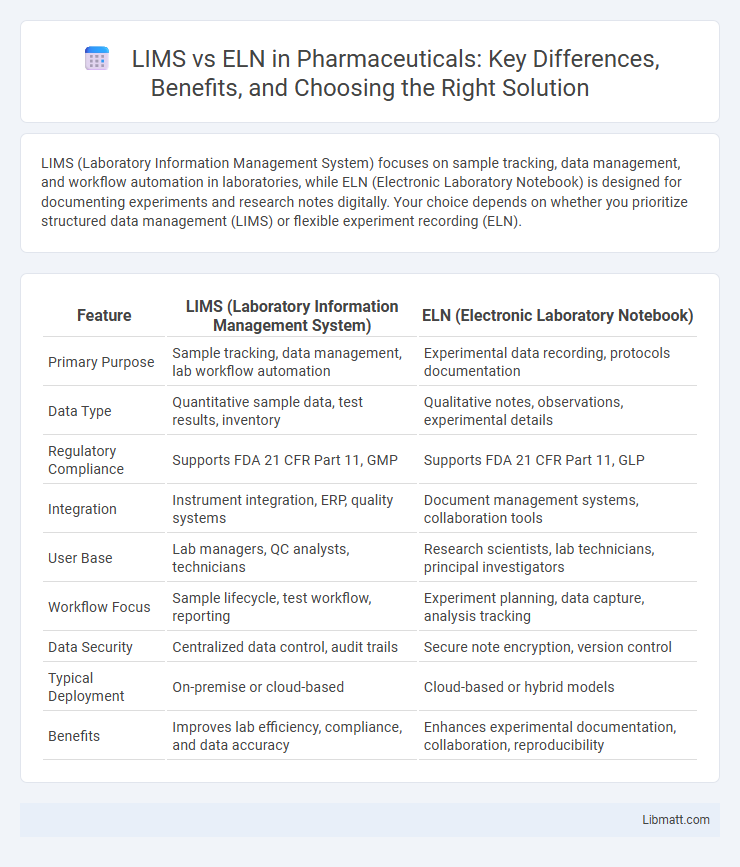LIMS (Laboratory Information Management System) focuses on sample tracking, data management, and workflow automation in laboratories, while ELN (Electronic Laboratory Notebook) is designed for documenting experiments and research notes digitally. Your choice depends on whether you prioritize structured data management (LIMS) or flexible experiment recording (ELN).
Table of Comparison
| Feature | LIMS (Laboratory Information Management System) | ELN (Electronic Laboratory Notebook) |
|---|---|---|
| Primary Purpose | Sample tracking, data management, lab workflow automation | Experimental data recording, protocols documentation |
| Data Type | Quantitative sample data, test results, inventory | Qualitative notes, observations, experimental details |
| Regulatory Compliance | Supports FDA 21 CFR Part 11, GMP | Supports FDA 21 CFR Part 11, GLP |
| Integration | Instrument integration, ERP, quality systems | Document management systems, collaboration tools |
| User Base | Lab managers, QC analysts, technicians | Research scientists, lab technicians, principal investigators |
| Workflow Focus | Sample lifecycle, test workflow, reporting | Experiment planning, data capture, analysis tracking |
| Data Security | Centralized data control, audit trails | Secure note encryption, version control |
| Typical Deployment | On-premise or cloud-based | Cloud-based or hybrid models |
| Benefits | Improves lab efficiency, compliance, and data accuracy | Enhances experimental documentation, collaboration, reproducibility |
Introduction to LIMS and ELN
Laboratory Information Management Systems (LIMS) streamline sample tracking, data management, and workflow automation in laboratories, enhancing efficiency and regulatory compliance. Electronic Laboratory Notebooks (ELN) digitize experimental records, enabling real-time data capture, collaboration, and secure documentation of research processes. Both LIMS and ELN serve critical roles in modern labs by optimizing data integrity, accessibility, and operational productivity.
Defining LIMS: Key Features and Functions
LIMS (Laboratory Information Management System) is a software solution designed to manage and streamline laboratory operations by tracking samples, managing test data, and ensuring regulatory compliance. Key features include sample lifecycle management, workflow automation, data integration from instruments, and comprehensive reporting capabilities. By improving data accuracy and operational efficiency, LIMS supports quality control and laboratory accreditation processes.
Defining ELN: Key Features and Functions
An Electronic Lab Notebook (ELN) is a digital platform designed to replace traditional paper lab notebooks, enabling researchers to document experiments, protocols, and observations efficiently. Key features of an ELN include real-time data entry, search functionality, collaboration tools, and secure data storage with audit trails to ensure compliance with regulatory standards. You can streamline research workflows and improve data integrity by leveraging an ELN's capabilities for managing experimental data compared to a Laboratory Information Management System (LIMS), which primarily handles sample tracking and laboratory operations.
Core Differences Between LIMS and ELN
LIMS (Laboratory Information Management System) primarily manages sample tracking, data organization, and regulatory compliance in laboratory workflows, while ELN (Electronic Lab Notebook) focuses on digital documentation of experimental procedures, observations, and results. LIMS offers structured data management suited for high-throughput labs, enabling sample lifecycle management, whereas ELN provides flexible note-taking and collaboration tools tailored for researchers' scientific recording needs. You can choose between LIMS and ELN based on whether your priority is operational efficiency and sample tracking or scientific documentation and experiment reproducibility.
Use Cases: When to Choose LIMS
LIMS (Laboratory Information Management System) is ideal for laboratories requiring comprehensive sample tracking, regulatory compliance, and automated workflow management, especially in quality control, pharmaceutical, and clinical research environments. It excels in managing high volumes of sample data and integrating with instruments for data capture and reporting. Choose LIMS when the primary need is structured data management, audit trails, and compliance with industry standards such as FDA 21 CFR Part 11.
Use Cases: When to Choose ELN
ELN (Electronic Laboratory Notebook) is ideal for capturing experimental data, detailed methodologies, and lab notes in research and development settings, supporting real-time collaboration and intellectual property documentation. It excels in environments requiring flexible data entry, hypothesis tracking, and version control for scientific research projects. ELN is chosen over LIMS when the primary need is dynamic documentation of experiments rather than sample or workflow management.
LIMS and ELN Integration Possibilities
LIMS and ELN integration possibilities enable seamless data exchange between laboratory sample management and electronic record keeping, enhancing workflow efficiency and data accuracy. Integrating LIMS with ELN systems allows real-time synchronization of experimental data, sample tracking, and inventory management, reducing manual entry errors and improving compliance with regulatory standards. Your laboratory can benefit from unified platforms that support collaboration, traceability, and comprehensive data analytics across both systems.
Benefits of Implementing LIMS and ELN
Implementing a Laboratory Information Management System (LIMS) enhances sample tracking, data management, and regulatory compliance by centralizing laboratory workflows and ensuring data integrity. Electronic Lab Notebooks (ELN) improve experiment documentation, collaboration, and intellectual property management through digital record-keeping and real-time data sharing. Together, LIMS and ELN streamline your laboratory operations, increase productivity, and accelerate research outcomes by integrating data capture with laboratory process management.
Challenges and Considerations in Adoption
LIMS implementation often faces challenges such as high initial costs, complex customization, and integration with existing laboratory instruments, requiring thorough planning and robust IT support. ELN adoption demands considerations on data security, user adaptability, and seamless collaboration features to ensure accurate electronic record-keeping and compliance with regulatory standards. Both systems require stakeholder engagement, training programs, and evaluation of laboratory workflows to maximize efficiency and return on investment.
Future Trends: The Evolution of LIMS and ELN
Emerging trends in Laboratory Information Management Systems (LIMS) and Electronic Lab Notebooks (ELN) highlight increased integration with Artificial Intelligence (AI), machine learning, and cloud computing to enhance data analytics and collaboration. The convergence of LIMS and ELN platforms aims to provide unified workflows that improve sample tracking, experiment documentation, and regulatory compliance. Future innovations will emphasize real-time data accessibility, advanced automation, and interoperability with Internet of Things (IoT) devices to drive smarter laboratory environments.
LIMS vs ELN Infographic

 libmatt.com
libmatt.com